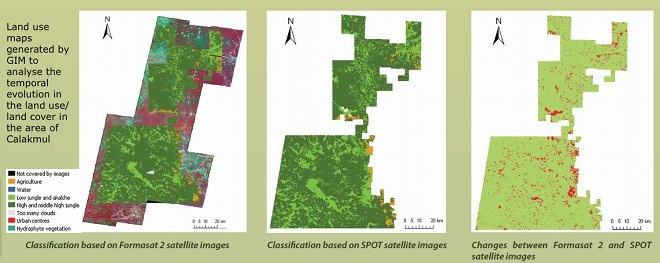The tropical rain forests round the sprawling Maya site of Calakmul (Mexico) was recognised as natural world heritage site at the UNESCO summit held in Qatar in June. Calakmul joined the select circle of places that can call themselves “mixed cultural and natural world heritage” sites. This new recognition was made possible thanks to an advanced information system for heritage sites, made in Belgium.
A Belgian consortium headed by GIM, a Belgium-based firm specialised in GIS software and Earth Observation services, delved into improving the information management for the Calakmul site in Mexico.
Together with the Universities of Leuven, Ghent and Liège, GIM developed an instrument that enables the managers of Calakmul to collect, manage and disseminate all available information on the site. The geographic information system uses technology such as satellite images and 3D models to map the sprawling heritage site and its natural environment.
Managers of major heritage sites are often faced with the same challenges: how do you manage efficiently the enormous amount of information about the site? How do you document how the site has evolved through time? What actions are necessary to ensure the preservation of the site?
To provide an answer to such questions, the Belgian Science Policy (BELSPO) concluded a framework contract with UNESCO. This agreement provided for a series of research and development projects geared to managing UNESCO heritage information better.
Heritage in 4D
One unique feature is that the time dimension can be integrated in spatial analyses. This gives managers insight into the ecological and archaeological developments through time. Because of this extra dimension, the system was christened “Calakmul 4D GIS.”
Temporal evolution analysis
High resolution land use maps (representing the situation in 2002-2003 and 2008-2009) of the entire Biosphere Reserve were generated by GIM, based on new Formosat 2 and archive SPOT satellite images. These land use maps can be used to analyse the
temporal evolution of the land use/land cover in the area. The new land use maps were compared to each other and to the available old land use map (1996-2000) to detect the changes and identify potential threats.
Formosat-2 imagery was also used to investigate the potential of remote sensing to document Maya ruins and detect evidences of the presence of archaeological remains in a tropical forest environment. This data set has been processed using innovative object-based image analysis techniques.
About Clakamul 4D
Calakmul 4D GIS is based on the GIM GeoCMS, an advanced Content Management System (CMS) that combines the traditional properties of a web CMS (management and publication of information via the Web) with the spatial analysis and display features of a Geographic Information System.
Calakmul 4D GIS enables managers of large heritage sites to document, monitor and manage the archaeological and ecological situation of the heritage site. The system features a virtual visit to the site as well as support for the time dimension. A special module was recently created to compile a comprehensive nomination file for UNESCO world heritage. Managers can now create their nomination file in the format required by UNESCO at the push of a button. This was demonstrated with two successful UNESCO world heritage nominations in 2014: the Calakmul site in Mexico and a first transnational portion of the Silk Roads in Central Asia.
Contact
Vincent Tigny, Team Manager Earth Observation, GIM (Geographic Information Management nv) - vincent.tigny@gim.be - telephone +32 16 40 30 39
Brigitte Decadt, International Cooperation, Belgian Science Policy (BELSPO) / Joost Vandenabeele, Space Research and Applications, STEREO Programme, Belgian Science Policy (BELSPO)
Links
- Ancient Maya City and Protected Tropical Forests of Calakmul, Campeche: http://whc.unesco.org/en/list/1061
- CALAKMUL BELSPO project: Development and use of a 4D Geographic Information System to support the conservation of the Calakmul site: http://eo.belspo.be/Directory/ProjectDetail.aspx?projID=838
About GIM
GIM – Geographic Information Management nv – specialises in products and services for the management of geographic information. It pools its expertise in geographic information systems, geomarketing, geo ICT, geo data and Earth Observation to provide unique insights into the spatial dimension of its customers’ activities. A multi-disciplinary team of nearly fifty geographers, engineers, physicists and IT scientists at the facilities in Leuven and Gembloux works on smart geo products and solutions for companies and governments. (www.gim.be)
About Belspo
The Belgian Science Policy and the ten federal scientific institutes are tasked with capitalising to the maximum on Belgium’s scientific and cultural potential for the benefit of policymakers, industry and citizens: “a policy by and for science.” BELSPO has been supporting the “Earth sciences” at UNESCO for several years, pursuant to a UNESCO – EAS agreement geared to encouraging the use of earth observation satellites for the monitoring of world heritage sites. The involvement of BELSPO means not only direct support for the World Heritage Centre, but also through the financing of projects, namely the national Earth Observation programme STEREO, which enables scientists and Belgian companies to develop their expertise and apply it in innovative fields (use of satellite images, GIS and GPS, 3D modelling, etc.). (www.belspo.be)


This page has no comments.